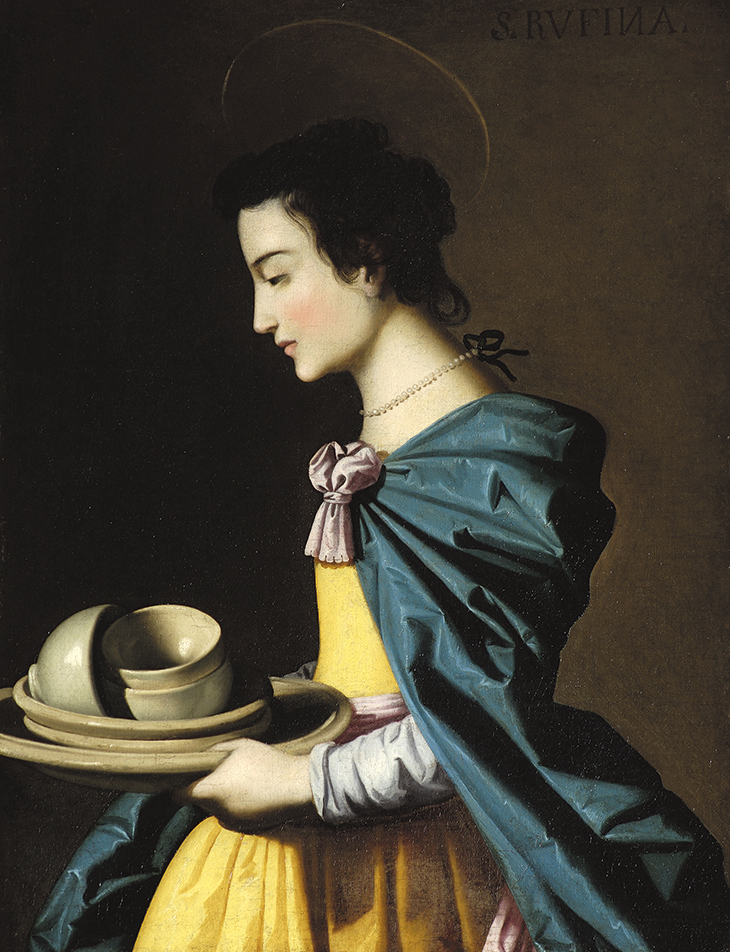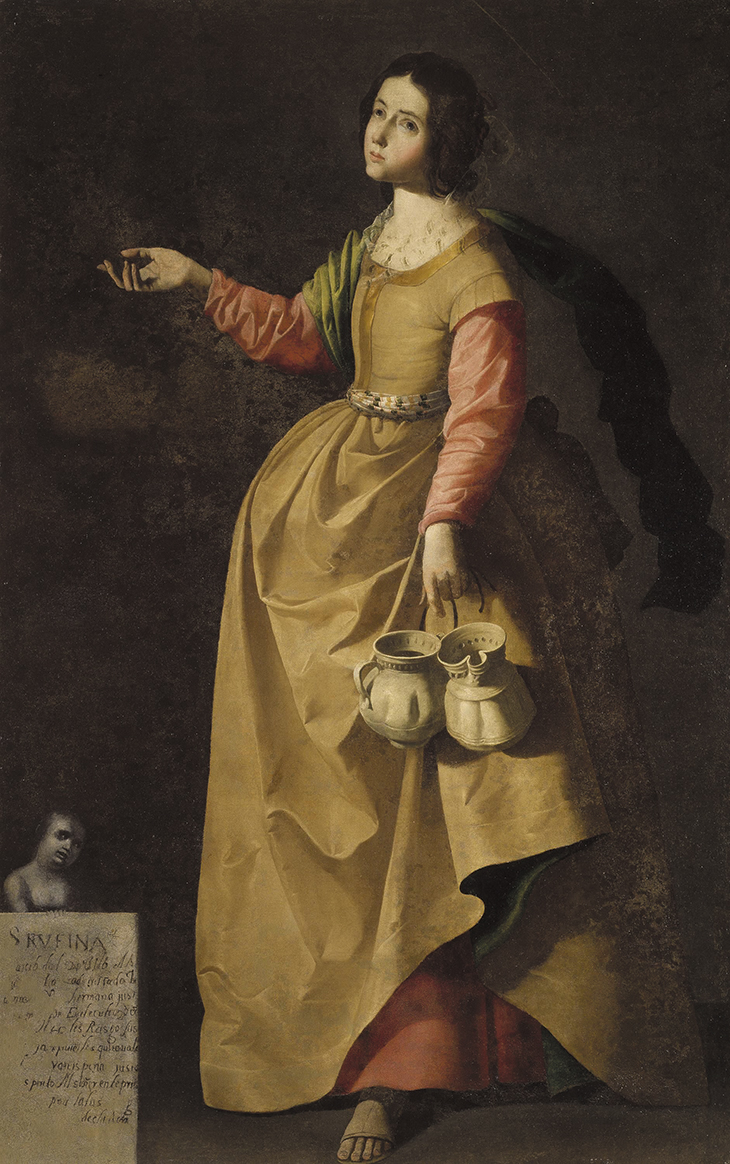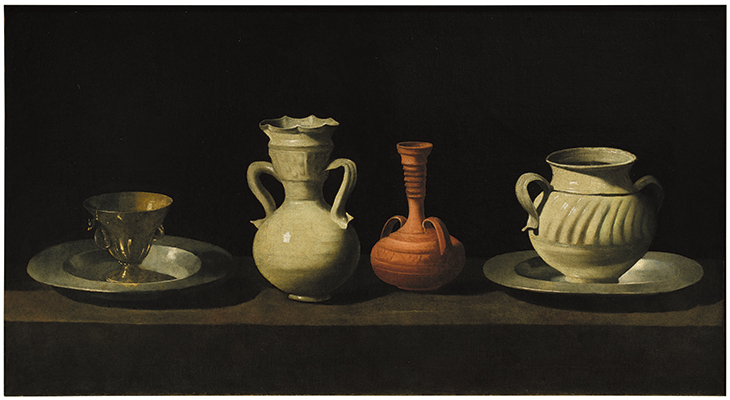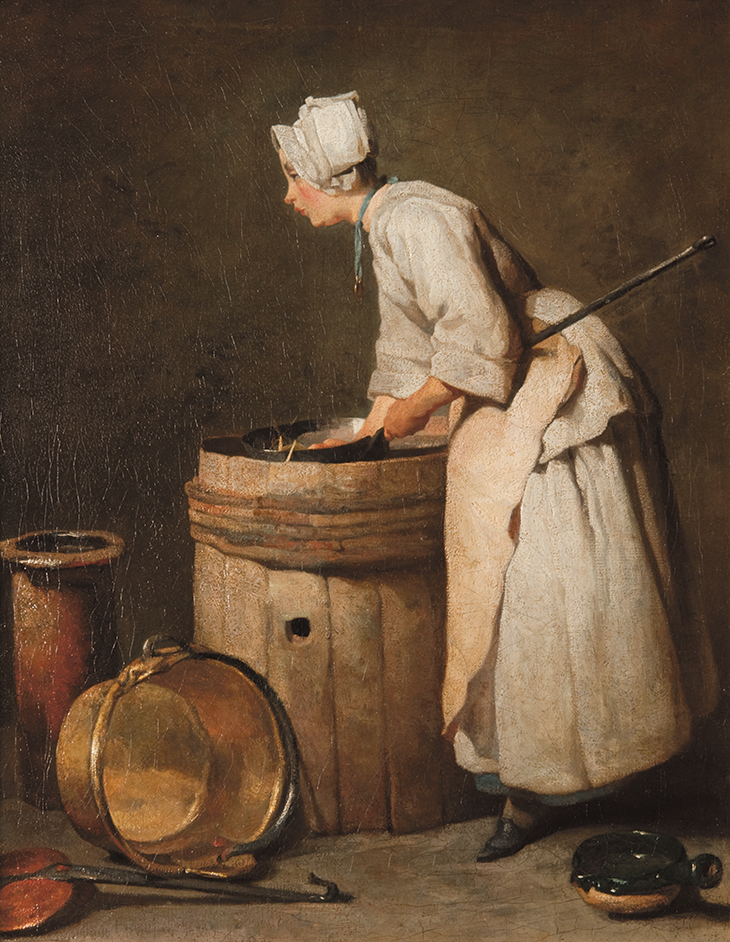In the Hunterian Art Gallery, Glasgow, hang two companion pieces by Jean-Siméon Chardin, The Cellar Boy and The Scullery Maid. In each, a young servant, dressed in white, rinses a utensil in a large wooden vat: the maid is scouring a frying pan, the boy cleaning a large jug. But each is also paused at their work: the boy’s brush is slack in the ewer, and his gaze fixed off to the right. The maid is inclined over her work, the tilt of her back implying the effort of scrubbing she would otherwise be exerting. But, like the boy, she is caught by something out of our view beyond the left of the frame. Her gaze parallels the angle of the handle of her pan, and extends outside the picture. We cannot see what they are looking at; or rather what they are not looking at, since it seems integral to the images that the arrest of their duties comes from an inward prompt.
The Cellar Boy (c. 1738), Jean-Siméon Chardin. Photo: © The Hunterian, University of Glasgow 2018

The topic of absorption in Chardin’s genre work has been live since the publication in 1980 of Michael Fried’s study of 18th-century French painting, Absorption and Theatricality, in which Chardin’s unfashionable interest in such pictures of domestic and unhistorical scenes is seen as a reinvigoration of what Fried called an ‘absorptive tradition’, which took images of figures in meditation, reflection, and obliviousness as its primary subject. What had been a devotional genre, he suggests, becomes in Chardin a secularised interest in models of attention, and in scenes that suspend action to imply a stilled duration. But The Scullery Maid and The Cellar Boy differ from the paintings on which Fried’s discussion of Chardin rests – paintings of readers, artists sketching, children playing knucklebones, blowing bubbles, building houses of cards – because, in those, the central figure’s attention is absorbed in the activity they are undertaking: activities that are unproductive but nonetheless pursued with a concentration which is fully engaged. They depict the seriousness of play. In The Scullery Maid and The Cellar Boy, however, we see not absorption in an activity, but a hiatus in it: work and repetitive, habitual gestures interrupted.
The Scullery Maid and The Cellar Boy also differ from these domestic scenes in another respect. Their stilled central figures, caught in contemplation, are surrounded by an array of vessels. As well as the wooden vat and the ewer he is resting on it, the boy stands near a large brown earthenware jug, a glass bottle with a metal funnel, and a strange red trilobate bucket. The maid is accoutred with a chimney-shaped earthenware pot, an overturned metal skimmer, and a small casserole. What draws the eye most charismatically on this canvas is the large copper basin, resting on its side: the beaten copper glows, catching and reflecting the light as if it were its source.
Such bravura exercised on a tub suggests one of the opportunities these compositions afforded Chardin: the practice and demonstration of skill in the execution of different materials, volumes, and surfaces, with their various properties of absorbing and reflecting light, or suggesting the shaping of air in the vacancy of the empty vessel. The paintings thus also establish two regimes of attention: the exquisitely attentive rendering of the quotidian objects with which the central figures are surrounded, especially the luminous, almost numinous cauldron in The Scullery Maid, on the one hand; and the utter inattention to those same objects on the part of those figures. The artist’s attention to the objects, and our enjoyment of it, runs athwart the ostensible human subject of the painting.
Still Life with Copper Cauldron (c. 1734–35), Jean-Siméon Chardin. Photo: © Roger-Viollet/Musée Cognacq-Jay, Paris

In their attentiveness to the surface of things, these paintings reach across from genre painting into Chardin’s other major form, still life. Several of the vessels depicted, or close siblings to them, also appear in his kitchen still lifes, in which utensils and foodstuffs are disposed on a simple stone ledge, against a plain background similar in tone to the walls at the back of the Glasgow paintings. In a still life now in the Musée Cognacq-Jay, Paris, for example, six elements are arranged: a mortar and pestle, a brown earthenware bowl, a knife, two onions, and another copper cauldron, lying on its side. The arrangement seems at once contingent, and live with significance of form and implication. The upright mortar and pestle, standing separately from the other objects, suggest a chrismatory, imparting something altar-like to the stone ledge; the other elements however keep the image in the realm of the quotidian. The knife, its handle extending over the ledge’s rim, offers an impression of depth, and also refers to early Dutch meal still lifes, which likewise congregate unpretentious elements, and in which a knife handle extending to the viewer is a motif. Again, the copper cauldron is decisive in the composition: the largest, dominating element, it offers a form of rhythmic circles as well as its tempered, gleaming surface; resting on its side, it also gently destabilises the stasis of the resting objects. A similar still life in the Louvre re-establishes stability by placing the copper pot on its base, but the knife’s role in supplying depth is replaced by a spring onion; a small pot occupies the suggestive role of the mortar and pestle. In a slightly busier still life in the Mauritshuis, the spring onions are doubled; the mortar and pestle recur, as does a casserole similar to that in The Scullery Maid, and again a copper cauldron appears, whose unsettling influence on the composition is here supplied by a lid, slightly ajar. In all of these paintings, simple vessels – copper cauldrons, casseroles – play a role in the composition of containing depth, organising space, and shaping vacancy.
It is common to say of Chardin’s still lifes that his attention invests the quotidian and simple with a dignity that renders them, against the currents of painting in his time, exquisite and apt subjects for art. Marcel Proust, in an early essay contrasting Chardin with Rembrandt, begins with a narrative sequence of a young man disgusted by the degraded, common stuff of his domestic life, who then, seeking elevation in the Louvre, discovers it not in the great heroic and historic paintings, but, precisely, in Chardin’s attentiveness to the commonplace, which reveals that it was not his surroundings but his mode of attention that had been at fault. The Cellar Boy and The Scullery Maid, however, tug us in a different direction: giving us oblivious figures among the elements of the sublimely realised still lifes.
St Rufina (n.d.) studio of Francisco de Zurbarán Photo: © The Fitzwilliam Museum, Cambridge

This trope, rare in Chardin, is more common in earlier traditions, especially in works painted in Seville by Zurbarán, Velázquez, and Murillo in the earlier part of the 17th century. In a painting in the Fitzwilliam Museum, Cambridge, attributed to the studio of Zurbarán, a woman in a yellow dress and a blue silk cloak stands in profile, facing left. She is carrying a plate, a dish, and three bowls, their simplicity in contrast to her sumptuous dress. The faint nimbus of a halo and a heading tell us that this is Saint Rufina, who along with her sister Justa (sometimes Justina) was martyred in Seville in the third century. The girls were daughters of a potter, who refused to allow their father’s wares to be used in celebration of the cult of Venus. The angry worshippers broke their vessels; in retaliation, they smashed a statue of the goddess. They were then captured, racked, and starved; while Justa died during these torments, Rufina survived to be thrown to lions, who refused to touch her, recognising her holiness. She was finally strangled, or in some traditions, beheaded.
The sisters became patrons of potters and of Seville, and were often rendered in the 17th century by the city’s painters, though they were scarcely ever depicted outside Andalusia. Each of Velázquez, who was baptised in Seville in 1599 and received his training and early commissions there, Zurbarán, who was apprenticed in the city from 1614, and Murillo, a Sevillian native who trained there in the 1630s, painted versions, some for the city, and some, in the case of Zurbarán, for export to the Americas. The principal attributes for Justa and Rufina are not the instruments of their martyrdom, but ceramics: simple pots and jugs. The potential for metaphor in their refusal to worship Venus is clear: they destroy the idolatrous image of the goddess of love, preferring their own modest and undecorated vessels. The painted jugs, bowls, and plates reconstitute what has been smashed, and like Keats’s Grecian urn are still unravished.
In the Rufina made in Zurbarán’s workshop, we are again presented with the double regime of attention which characterised The Scullery Maid and The Cellar Boy. The rendering of the plates and bowls is beautiful, the reflections in the glaze and the blackness of shadow suggesting a brighter illumination from the left than seems to strike Rufina; the saint’s lowered eyes do not look at this artistic achievement, the angle of her gaze just missing the bowls and plates to land, again, beyond the edge of the painting. As in Chardin’s representations of the copper cauldron, the bowls offer a challenge to technique, in the depiction of light effects and their dimensionality. They also signify a shaping of interiority that corresponds to Rufina’s meditative concentration. Her eyes, like the scullery maid’s, are cast downwards. Again this is an inward looking, a focus not on a visible object of attention but on something apprehended internally: the patience and determination of the martyr. The association of the meditative object or vessel and saintly interiority is still clearer in Zurbarán’s alarming painting, Saint Francis of Assisi in his Tomb, now in the Milwaukee Art Museum: the saint’s high-peaked hood casts his face into shadow, as he contemplates a skull, cupped in his hands like a bowl.
Santa Rufina (1630s), Francisco de Zurbarán. Photo: © National Gallery of Ireland, Dublin

The fact that paintings of Rufina and Justa include pottery as attributes means that, like Chardin’s Scullery Maid and Cellar Boy, they are inevitably split between the representation of their human figures and the materials of still life. In one of Zurbarán’s own paintings of Rufina, now in the National Gallery of Ireland, Dublin, the saint points to the two white jugs that hang from a cord at her waist; in one of his very few still lifes, Still Life with Vessels, in the Prado, two similar white jugs stand in the row of four which make up the painting. The saint’s pointing finger – unlike the distracted gazes of the studio Rufina, and Chardin’s maid and boy – draws our attention to the vessels both as the attributes that signify her virginity, piety, and martyrdom, and as exercises of Zurbarán’s skill. The vessels persist in two dimensions: both spiritual sign, and the stubborn matter of the everyday.
Still Life with Vessels (c. 1650), Francisco de Zurbarán. Photo: © Photographic Archive Museo Nacional del Prado

This split is characteristic of the art of Seville in the early 17th century, perhaps most obviously in the works painted there by Velázquez before he moved to the court in Madrid in the 1620s. The period saw the rise in Spanish art of what are called bodegones, ‘tavern scenes’ or genre paintings of moments in low life. In several of these, such as The Waterseller of Seville, Velázquez depicts ceramics typical of the city district of Triana, with which Justa and Rufina were most associated. In others, he produced what John Drury has referred to as ‘double-yolked’ paintings. These divide the picture plane between a kitchen scene in the style of a bodegón in the foreground, and a framed biblical story in the background, which can be read ambiguously as a scene viewed through a window or a hatch, or a painting hung on the wall.
Such images, which Velázquez imitated and innovated after Dutch engravers and painters such as Pieter Aertsen, have two centres of gravity, stylistically, narratively, and formally. In the Kitchen Maid with the Supper at Emmaus, which now hangs in the National Gallery of Ireland, we see a servant – probably an enslaved black woman – in the middle of her labours. On the rough table in front of her are, again, the components of still life painting: jugs, bowls, garlic, a mortar and pestle for grinding it. There is also a dish that rests, somewhat precariously, against a white jug, almost rocking on its edge; like Chardin’s copper cauldron on its side, the tipping of the vessel towards the viewer both adds animation, and displays the painter’s skill. But over her right shoulder is a partial depiction, in a noticeably less realistic mode, of the Supper at Emmaus: the moment after the Resurrection, told in Luke’s gospel, when Christ’s disciples recognise him for the first time as he breaks bread with them.
Kitchen Maid with the Supper at Emmaus (c. 1617–18), Diego Velázquez. Photo: © National Gallery of Ireland, Dublin

The link between the two parts of the painting is made by the maid’s attention and distraction. Like Chardin’s scullery maid, she is caught in hiatus, paused, leaning forward with her work suspended. Her abstracted gaze, like that of the Cambridge Rufina, just misses the beautifully rendered objects before her. We interpret her, instead, as attending to something which she for two reasons cannot see: because she is not looking at it; and because the paraphernalia of dress and dishes place her firmly in 17th-century Andalusia, not 1st-century Palestine. Nonetheless we understand that she is concentrating on the moment depicted behind her, which is itself a moment of sudden recognition in the midst of the quotidian household matter of blessing and breaking bread.
What is particularly suggestive is that this painting exists in another state: a version in the Art Institute of Chicago depicts all of the elements of the Dublin painting, but without the Supper at Emmaus. (Even in the Dublin version, the supper was only revealed in cleaning in 1933.) Without the depiction of the biblical scene, we have no alternative object for the maid’s attention: instead, as in Chardin, the image becomes a picture of a servant paused, of suspended activity amid the busy stuff of still life. The retraction of the specifically sacred or devotional element sharpens a more general problem of interpretation with Spanish still life and bodegones: is there, in effect, a latent Supper at Emmaus in the corner of every painting, a sacred context which means that every piece of ceramic reminds us of the martyrdom of Justa and Rufina, each wine glass and each piece of bread of the Eucharist, any waterseller’s ewer of the wedding at Cana?
In Tom Lubbock’s beautiful essay on the Still Life with Vessels, he refers to Zurbarán’s ability to make ‘ordinary material things feel mystical, numinous, holy’ – not, in this case, through their juxtaposition with a saint, but through the effect of rendering light on ceramic, through ways of making each of the elements of the composition stand in its own particular illumination. For Zurbarán, this is a way not just of honouring the stuff of the everyday through artistic verisimilitude, through a passionate exercise of observation, but of suggesting that each thing is anyway so attended to, so that the artist’s practice of painting becomes an enactment and emulation of divine attention, which the painting’s viewers come to emulate in their turn. It is the opposite of the vanitas trope so often attributed to Dutch still life, with its luscious depiction of perishable things.
The Scullery Maid (c. 1738), Jean-Siméon Chardin. Photo: © The Hunterian, University of Glasgow 2018

What Lubbock says of Zurbarán, critics frequently say of Chardin, though in a more secular vein: that he has a capacity to render the everyday charismatic. Diderot said of The Scullery Maid that ‘if it weren’t for the sublimity of his technique, Chardin’s ideal would be miserable’: the attention of eye and exercise of skill bestows qualities of transcendence on the mundane. Yet when these still life elements share a canvas with human figures, the lavishing of attention on the inanimate objects is coupled with depictions of fixed negligence, of pointed distraction from the exquisitely observed stuff. In the case of Rufina, or of Velázquez’s kitchen maids, it is easy to suggest that this abstraction is a meditation on what lies behind or beyond the quotidian, on a spiritual dimension which can only be depicted by indirection, like the obliquity of the central figure’s gaze. Chardin’s figures seem less pledged to another realm. Though his cruets and mortars and pestles suggest uses both daily and sacramental, the vessels that surround the scullery maid and the cellar boy are rooted in the present world. Nonetheless, the Sevillian tradition of finding a correlative for their meditative figures in the vessels they carry or stand among persists. Chardin’s copper cauldron, like the awkwardly resting two-handled dish in Velázquez’s Kitchen Maid, and Rufina’s freight of ceramic bowls, offers its interior to us as a demonstration of the painter’s brilliance of technique in rendering both depth and surface: an analogy for the challenge of the depiction of abstraction, a shaping of vacancy of air or of the mind, a conjuring of concentration out of emptiness.
From the September 2018 issue of Apollo. Preview and subscribe here.


